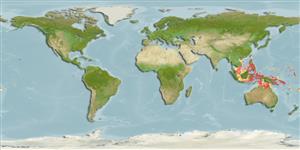Actinopterygii (ray-finned fishes) >
Syngnathiformes (Pipefishes and seahorses) >
Syngnathidae (Pipefishes and seahorses) > Hippocampinae
Etymology: Hippocampus: Greek, ippos = horse + Greek,kampe = curvature (Ref. 45335); denise: Named after Denise Tackett; noun in apposition.. More on author: Randall.
Environment / Climate / Range
Ecology
Marine; reef-associated; non-migratory; depth range 13 - 90 m (Ref. 47053). Tropical, preferred ?
Western Pacific: apparently more widespread than Indonesia, Vanuatu and Palau. Observed from Malaysia, Solomon Islands and Pohn Pei, Micronesia. International trade is monitored through a licensing system (CITES II, since 5.15.04).
Length at first maturity / Size / Weight / Age
Maturity: Lm 1.1 range ? - ? cm
Max length : 2.2 cm SL male/unsexed; (Ref. 47053); 2.4 cm SL (female)
Short description
Morphology | Morphometrics
Dorsal
soft rays
(total): 14. Color in life plain orange with slightly darker rings around tail; when preserved, pale orange with tiny dark brown flecks on the nape of the neck and all over in some specimens. Diminutive in size. Anal fin small or absent. Rings on trunk 12; on tail 28-29. Body fleshy with inferior and ventral trunk ridges reduced to separated cross-shaped spicules embedded in the skin. Nuchal plate rounded without a raised coronet. Snout length ca. 30% in HL. Head depth ca. 50% in HL. No spines above the eye. Trunk depth (between the 9th and 10th trunk rings) ca. 7% in SL (female) and 10-15% in SL (male). The angles of certain body ridges sometimes developed into rounded tubercles (distinctly fewer and less developed compared with H. bargibanti) (Ref. 47053).
Lives in association with gorgonian seafans (Annella reticulata, Muricella sp., and Echinogorgia sp.). Master of camouflage, with their coloration and body ornamentation in the form of tubercles, can match the stems and polyps of their gorgonian hosts (Ref. 47053). Ovoviviparous (Ref. 205). The male carries the eggs in a brood pouch which is found under the tail (Ref. 205).
Life cycle and mating behavior
Maturity | Reproduction | Spawning | Eggs | Fecundity | Larvae
Male carries the eggs in a brood pouch (Ref. 205).
Lourie, S.A. and J.E. Randall, 2003. A new pygmy seahorse, Hippocampus denise (Teleostei: Syngnathidae), from the Indo-Pacific. Zool. Studies 42(2):284-291. (Ref. 47053)
IUCN Red List Status (Ref. 115185)
Threat to humans
Harmless
Human uses
More information
Age/SizeGrowthLength-weightLength-lengthLength-frequenciesMorphometricsMorphologyLarvaeLarval dynamicsRecruitmentAbundance
ReferencesAquacultureAquaculture profileStrainsGeneticsAllele frequenciesHeritabilityDiseasesProcessingMass conversion
Tools
Special reports
Download XML
Internet sources
